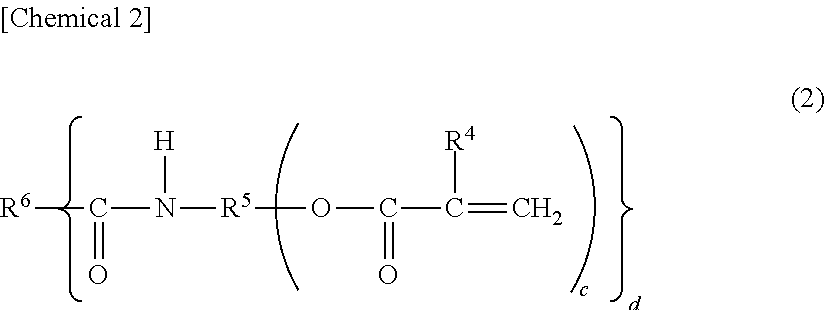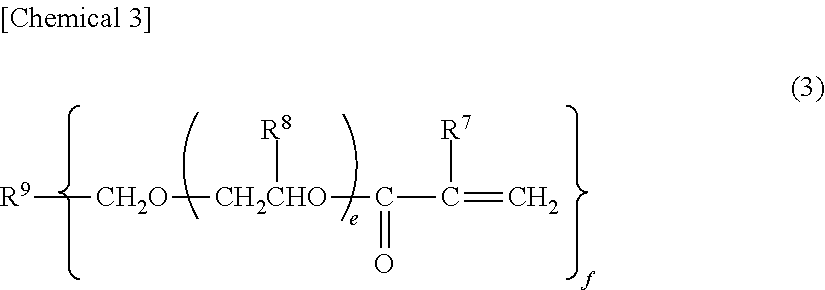Photochromic curable composition
- Summary
- Abstract
- Description
- Claims
- Application Information
AI Technical Summary
Benefits of technology
Problems solved by technology
Method used
Image
Examples
production example 1
Production of the (meth)acrylic-amide polymerizable monomer (A1) AM-01
[0458]β-Methacryloyloxyethylhydrogen succinate, 23.0 g (0.1 mol),[0459]2,2,4-Trimethylhexamethylenediamine, 7.9 g (0.05 mols), and[0460]Dimethylaminopyridine, 12.2 g (0.1 mol),
were dissolved in 200 mL of tetrahydrofuran, and to which,[0461]1-Ethyl-3-(3-dimethylaminopropyl) carbodiimide hydrochloride (WSC), 23.0 g (0.12 mols),
was added little by little.
[0462]After stirred overnight at room temperature, the precipitated solid material was separated by filtration. The filtrate was concentrated under reduced pressure and was refined by column chromatography using neutral alumina to obtain 7.0 g of a transparent viscous liquid. The yield was 24%.
[0463]The obtained viscous liquid was measured for its proton nuclear magnetic resonance spectra to find peaks of 40H based on the methyl and methylene proton near 0.5 to 4.9 ppm and peaks of 4H based on the vinyl proton of the unsaturated bond near δ 5.0 to 6.0 ppm.
[0464]From ...
production example 2
Production of the (meth)acrylic-amide polymerizable monomer (A1) AM-02
[0471]The operation was carried out in the same manner as in the Production Example 1 but using a γ-carboxydicaprolactone monoacrylate, 30.0 g (0.1 mol), instead of using the β-Methacryloyloxyethylhydrogen succinate to obtain 7.6 g of a transparent viscous liquid. The yield was 21%.
[0472]The obtained viscous liquid was measured for its proton nuclear magnetic resonance spectra to find peaks of 58H based on the methyl and methylene proton near 0.5 to 4.9 ppm and peaks of 6H based on the vinyl proton of the unsaturated bond near δ 5.0 to 6.0 ppm.
[0473]Based on the infrared absorption analytical method, further, an absorption peak stemming from the amide bond was observed at 1650 cm−1.
[0474]The product was elementally analyzed to be as follows:
[0475]C, 64.66%; H, 9.34%; N, 3.72%
[0476]The C39H66N2O10 was calculated to be as follows:
[0477]C, 64.79%; H, 9.20%; N, 3.87%
[0478]It was learned from the above that the analyti...
production example 3
Production of the (meth)acrylic-amide polymerizable monomer (A1) AM-04
[0480]Tetramethylolmethane triacrylate, 29.8 g (0.1 mol), and[0481]Succinic anhydride, 11.8 g (0.1 mol),
were dissolved in 500 mL of toluene, and to which,
[0482]p-Toluenesulfonic monohydrate, 190 mg (0.001 mol) was added, and the mixture was heated and refluxed for 3 hours.
[0483]The reaction solution was concentrated under reduced pressure and was refined by column chromatography using neutral alumina to obtain 37.40 g of a transparent viscous liquid. To the viscous liquid, there added,[0484]Hexamethylenediamine, 5.8 g (0.05 mols), and[0485]Dimethylaminopyridine, 12.2 g (0.1 mol),
the mixture thereof was dissolved in 200 mL of the tetrahydrofuran, and to which,[0486]1-Ethyl-3-(3-dimethylaminopropyl) carbodiimide hydrochloride (WSC), 23.0 g (0.12 mols),
was added little by little.
[0487]After stirred overnight at room temperature, the precipitated solid material was separated by filtration. The filtrate was concentrate...
PUM
| Property | Measurement | Unit |
|---|---|---|
| Percent by mass | aaaaa | aaaaa |
| Mechanical strength | aaaaa | aaaaa |
| Density | aaaaa | aaaaa |
Abstract
Description
Claims
Application Information
 Login to View More
Login to View More - R&D
- Intellectual Property
- Life Sciences
- Materials
- Tech Scout
- Unparalleled Data Quality
- Higher Quality Content
- 60% Fewer Hallucinations
Browse by: Latest US Patents, China's latest patents, Technical Efficacy Thesaurus, Application Domain, Technology Topic, Popular Technical Reports.
© 2025 PatSnap. All rights reserved.Legal|Privacy policy|Modern Slavery Act Transparency Statement|Sitemap|About US| Contact US: help@patsnap.com



